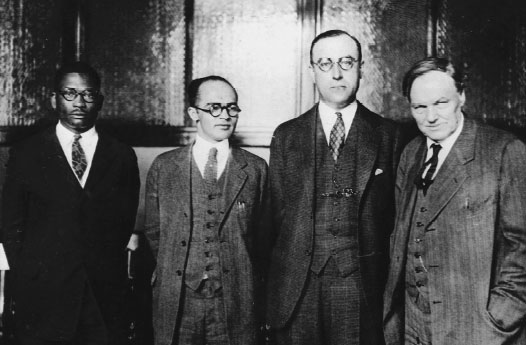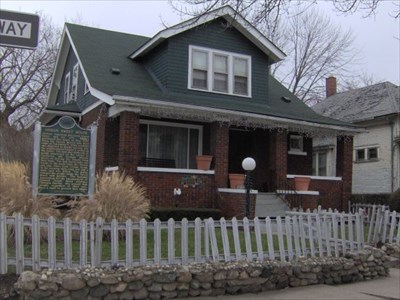
As reported in the Houston Chronicle, "'Arc of Justice' by Kevin Boyle: Hate's new house. Historian's 1926 Detroit story captures depth of racial enmity," by Steve Weinberg, 5 September 2004 -- "The Past Is Prologue," say the words cut into the facade of the National Archives building in Washington, D.C. Those four words have inspired my historical writings for decades. But rarely do historians make the past jump off the page, much less show contemporary relevance compellingly.
Kevin Boyle is a welcome exception when it comes to the history of racial enmity in 20th-century America, told mostly through the lens of housing segregation in burgeoning Northern cities. Using one dramatic case to illuminate the bigger picture, Boyle has written a book that ought to become a standard text and might just become a classic of historical literature.
It is no secret that in 1925 impoverished Negroes (the common term then, as Boyle notes) migrated from Southern towns to Northern cities in large numbers. On the opening page of this compelling, depressing book, history professor Boyle uses railroad stations in towns throughout the South as his setting, mentioning how those trains passed through "the squalid lumber camps of East Texas" on the way to what might be a better life.
One of the most frequent destinations: Detroit, Boyle's native city. The migration resulted in lots of hardworking, inexpensive laborers to staff automobile factories and other industries. Unfortunately, the influx of dark-skinned Americans only a few generations removed from legally sanctioned slavery also led to racial tensions that ended in lynchings, stabbings, bombings and shootings.

In Detroit, much of the tension revolved around Negroes wanting nice housing, which usually could be found only in "white" neighborhoods and only rarely in "ghettos" such as Detroit's Black Bottom. One of the Negroes wanting a nice home with a yard for himself, his wife Gladys and their infant daughter was Ossian Sweet. Age 29 in 1925, Sweet had been born black and poor in Florida, had struggled to earn a bachelor's degree at all-black Wilberforce University in Ohio, then had completed a medical degree at all-black Howard University of Washington, D.C. He had moved to Detroit in 1921, married the Pittsburgh-bred Gladys, built a thriving medical practice in Black Bottom and helped establish a ghetto hospital.
Ossian and Gladys Sweet were not naive; they understood the hatred and violence they might encounter if they became the first Negro occupants of the bungalow on the northwest corner of Garland and Charlevoix, outside Black Bottom. But they refused to give up their dream because of hate-filled, ignorant Caucasians. So the Sweets made the purchase, after Detroit police promised protection during the move.
The police supervisor who would bear the brunt of the responsibility carried the name Norton Schuknecht, a 55-year-old lifelong Detroit resident. He did not welcome the assignment. He knew most if not all of his all-white crew hated Negroes; some of the cops belonged to the Ku Klux Klan. Yet they had been ordered by Mayor Johnny Smith to reduce racial violence before Detroit ended up with the muddied reputations of Chicago and Washington, D.C.
According to Boyle's research, Schuknecht faced what he viewed as a difficult choice. If violence visited the Sweets during the move, the mayor might fire him. But Schuknecht knew that his cops had joined the force to defend the sanctity of white neighborhoods, "not to stand down people just like themselves so a Negro could live in a place where he didn't belong."
When the Sweets' moving day arrived, Schuknecht stationed police officers near the house, as promised. He appears to have decided, however, to allow the inevitable white mob "to drive the coloreds out."

Dr. Sweet wanted to trust the police. He decided, though, that discretion would be the better part of valor. So he arranged for his two brothers, social friends and work colleagues to keep watch -- nine showed up on the fateful day-- and stocked the house with guns.
In the evening, with most of the furniture moved in, the white mob swelled to hundreds, maybe thousands, Boyle's research suggests. Stones pelted the house. Panicked, somebody inside fired shots. A white man lay dead on the street. Police arrested Ossian and Gladys Sweet, as well as the other nine men inside.

The arrests occur on Page 170. The second half of the book is devoted mainly to the trial (ending in a hung jury), the retrial (ending in an acquittal), the death of Gladys at age 27 due to disease, Ossian's downward spiral ending in his 1960 suicide -- two years after finally selling the bungalow. The second half is populated by now-famous individuals, especially defense attorney Clarence Darrow and future U.S. Supreme Court Justice Frank Murphy.
Despite the importance of such characters, racial hatred is the leading protagonist. Boyle, who teaches at Ohio State University, is masterful at placing every nuance of the Sweet case within a larger context, not only in Detroit but nationally. He closes the book in 1960. Since then, of course, many blacks have moved to nice housing in mostly white neighborhoods without encountering physical violence. Under the superficially pleasant surface, however, racial tension is rarely absent. Sad to say, Boyle's "historical" account is all too descriptive of life in 2004. [(source: ) Steve Weinberg has worked as a journalist in the racially tense cities of East St. Louis, Ill., and Washington, D.C. He currently lives in Columbia, Mo.]
Kevin Boyle - Arc of Justice - Part 1


No comments:
Post a Comment